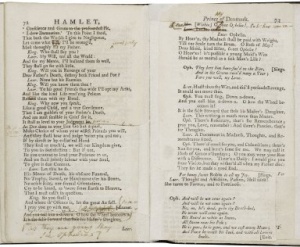Promptbooks: Difference between revisions
SophieByvik (talk | contribs) mNo edit summary |
SophieByvik (talk | contribs) (added image) |
||
| Line 1: | Line 1: | ||
The Folger collection includes over 1,800 promptbooks, about half of which are for Shakespearean productions. Strictly speaking, “promptbooks” are printed play texts marked up prior to performance in order to indicate for the stage prompter the cuts, changes, additions, entrances and exits, and other stage business he is to follow in conducting the performance. Other marked-up play texts, also called promptbooks, provide evidence not of a prompter’s on-stage work, but of prior preparation. | The Folger collection includes over 1,800 promptbooks, about half of which are for Shakespearean productions. Strictly speaking, “promptbooks” are printed play texts marked up prior to performance in order to indicate for the stage prompter the cuts, changes, additions, entrances and exits, and other stage business he is to follow in conducting the performance. Other marked-up play texts, also called promptbooks, provide evidence not of a prompter’s on-stage work, but of prior preparation. | ||
[[File:PROMPT Ham. 16.jpg|300px|right|thumb|Pages 72 and 73 of David Garrick's 1772-1773 ''Hamlet'' promptbook. PROMPT Ham. 16.]] | |||
This "preparation [http://shakespeare.folger.edu/cgi-bin/Pwebrecon.cgi?BBID=132231/ promptbook]" for Garrick’s controversial revision of [[Hamlet|''Hamlet'']] for the 1772–73 season is not yet ready to be acted—or prompted—from but helps establish many of the radical changes Garrick made to Shakespeare’s play. In working on this version, Garrick did not use his own previously-published acting edition, first printed in 1763. Instead he marked up a 1747 copy of the standard text of the time (the version by Robert Wilks and John Hughs) and in some places pasted in leaves from his own 1763 text. Garrick divided the acts differently while reinstating over six hundred lines to the first three acts. But his most extensive changes were to condense the fourth and fifth acts where he deleted not only the popular gravediggers’ scene but also the fencing match between Laertes and Hamlet. Instead of this “rubbish” (as he called these scenes), Garrick considered multiple possible endings. | This "preparation [http://shakespeare.folger.edu/cgi-bin/Pwebrecon.cgi?BBID=132231/ promptbook]" for Garrick’s controversial revision of [[Hamlet|''Hamlet'']] for the 1772–73 season is not yet ready to be acted—or prompted—from but helps establish many of the radical changes Garrick made to Shakespeare’s play. In working on this version, Garrick did not use his own previously-published acting edition, first printed in 1763. Instead he marked up a 1747 copy of the standard text of the time (the version by Robert Wilks and John Hughs) and in some places pasted in leaves from his own 1763 text. Garrick divided the acts differently while reinstating over six hundred lines to the first three acts. But his most extensive changes were to condense the fourth and fifth acts where he deleted not only the popular gravediggers’ scene but also the fencing match between Laertes and Hamlet. Instead of this “rubbish” (as he called these scenes), Garrick considered multiple possible endings. | ||
Revision as of 09:40, 23 August 2014
The Folger collection includes over 1,800 promptbooks, about half of which are for Shakespearean productions. Strictly speaking, “promptbooks” are printed play texts marked up prior to performance in order to indicate for the stage prompter the cuts, changes, additions, entrances and exits, and other stage business he is to follow in conducting the performance. Other marked-up play texts, also called promptbooks, provide evidence not of a prompter’s on-stage work, but of prior preparation.
This "preparation promptbook" for Garrick’s controversial revision of Hamlet for the 1772–73 season is not yet ready to be acted—or prompted—from but helps establish many of the radical changes Garrick made to Shakespeare’s play. In working on this version, Garrick did not use his own previously-published acting edition, first printed in 1763. Instead he marked up a 1747 copy of the standard text of the time (the version by Robert Wilks and John Hughs) and in some places pasted in leaves from his own 1763 text. Garrick divided the acts differently while reinstating over six hundred lines to the first three acts. But his most extensive changes were to condense the fourth and fifth acts where he deleted not only the popular gravediggers’ scene but also the fencing match between Laertes and Hamlet. Instead of this “rubbish” (as he called these scenes), Garrick considered multiple possible endings.
